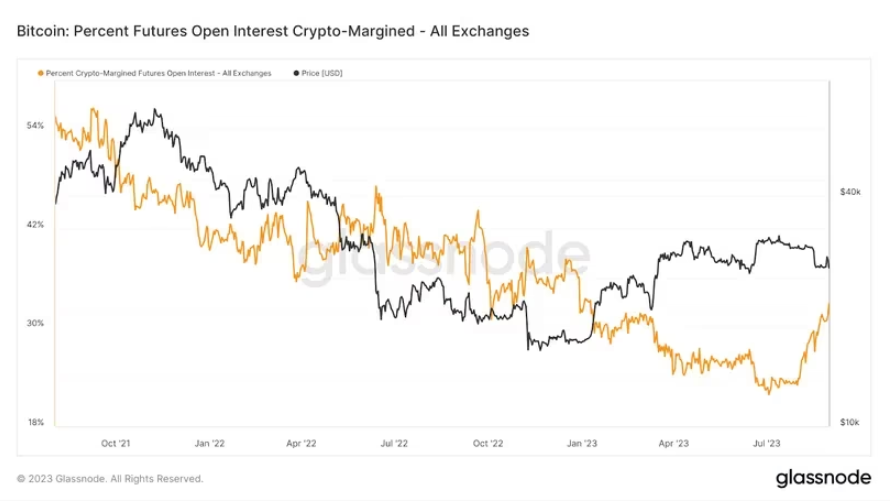- Since July, data tracked by Glassnode suggests that Bitcoin futures open positions have increased by 33%, up from about 20% previously.
- Futures are leveraged products that allow traders to maximize exposure to deposits known as collateral on the exchange.
- Such occurrences were quite common before September 2021 when coin-collateralized contracts made up over 50% of total open positions.
Traders are starting to show interest in Bitcoin-collateralized futures; what does this exactly mean? Is there a cash shortage in the market?
Bitcoin Becomes Traders’ Collateral Choice

Bitcoin (BTC) seems unlikely to shake off its label of being an unstable and volatile asset in the near future, as crypto traders are increasingly using the largest cryptocurrency as collateral in futures trading.
Since July, data tracked by Glassnode suggests that Bitcoin futures open positions have increased by 33%, up from about 20% previously. Cash or stablecoin-collateralized contracts still make up 65% of total open positions.
Futures are leveraged products that allow traders to maximize exposure to deposits known as collateral on the exchange; this can be done with a deposit that is a small percentage of the contract size. The exchange provides the rest of the value of the trade. The renewed interest in BTC-collateralized contracts carries the potential for liquidation waves that could increase volatility, according to research provider Blockware Intelligence. This happens when multiple liquidations, or forced position closures due to margin deficiencies, occur consecutively, resulting in rapid price changes.
Analysts at Blockware Intelligence stated in a weekly bulletin:
“If you have BTC and BTC is sent as collateral, a drop in the price brings you to your liquidation point faster as the value of your collateral drops simultaneously. Leveraging BTC with your BTC at the point of liquidation is highly risky, as you can be correct in direction but still get wiped due to volatility.”
Coin-collateralized contracts are quoted in U.S. dollars but collateralized and settled with cryptocurrencies. In other words, the collateral, which is as volatile as the collateral position, creates a non-linear payout that makes traders earn less during market rallies and lose more during market declines. This results in a relatively fast margin deficiency and a potential liquidation outcome.
The trend is concerning as liquidation waves that could increase volatility are more likely to occur if coin-collateralized contracts dominate. Such occurrences were quite common before September 2021 when coin-collateralized contracts made up over 50% of total open positions.
Market Cash Shortage
According to Blockware, the renewed interest in such contracts indicates a cash shortage in the market. Analysts said:
“The recent spike in this metric over the past couple of months is interesting, as it could show traders are having a cash crunch and have started to use their BTC as collateral as a last resort to increase their last exposures.”
Liquidity has been drying up in the crypto market for some time. According to CCData, the total market capitalization of all stablecoins decreased by 0.4% to $125 billion in August, representing a 17-month consecutive decline. Tether (USDT), the world’s largest stablecoin by market cap, lost nearly $1 billion over the past four weeks, falling to $82.87 billion, according to data.

